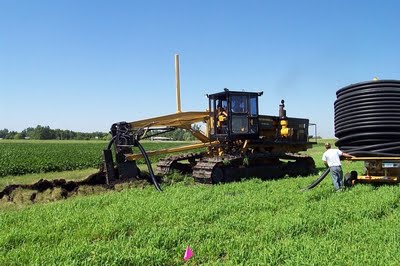Tile Drainage: Beneficial to Farmers and Non-Farmers Alike

Those of us in Production Agriculture know the benefits tile drainage can have on future crops in poorly drained fields. We also know that this land improvement investment is becoming more and more popular and will, most likely, be expanding on many more acres in the future.
As with most changes, there is controversy. The biggest and most dangerous controversy to production agriculture is the debate of how tile drainage effects flooding in the Red River Valley. Unfortunately, many of our friends and neighbors in the urban areas and those not involved in agriculture have the opinion that tile drainage is contributing to overland flooding. This is mostly coming from misconceptions and assumptions that are not fact based. In fact, tile drainage can actually do the opposite; it can help reduce flooding issues in many circumstances. Lets look at the effects tile drainage will have on flooding in two scenarios.
First, let’s look at the worst case scenario. If you were to pour water on a table top, how much water would you have to pour and how long would it take to spill over the edge? It probably wouldn’t take very much or very long, right? The table represents a bare field that is either frozen or very wet from the previous fall. The soil cannot absorb any more water in the spring. The water is going to run off the field in the same time with the same amount of water.
Now let’s look at a better scenario. This past winter we had very little frost in the ground due to late freezing temps and good snow cover. Our fields were wet going into the winter. If you put drain tile under that same field at four feet deep, what would most likely happen? The tiled fields keep draining well into December and beyond. Since the excess water was removed from the top four feet of soil in the fall and winter, the field acts like a sponge in the spring and can take on more water. This, in turn, possibly reduces and slows runoff helping a flood situation.
There are many variables that affect runoff water from fields. Soil type, surface drainage, infiltration rates of the soil, topography and other factors all affect runoff. There is no scientific data or studies that currently exist that show whether or not subsurface drainage has an effect either way on flooding. Eventually, if we could replace our surface drainage with subsurface drainage, it would have positive effects on reducing flooding and at the same time improve the soils for our crops to grow and thrive. This would reduce the “wet feet” of the root systems and lowering the salt contents that have progressively risen in our wet cycle of the past 15 years.
I encourage you to share this article with your urban neighbors to help them understand this issue better. Tile drainage is a benefit for farmers and non-farmers alike.











